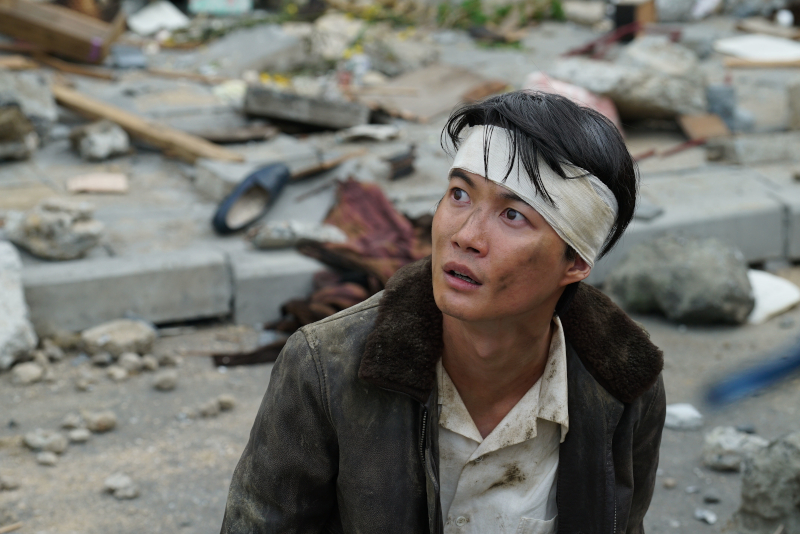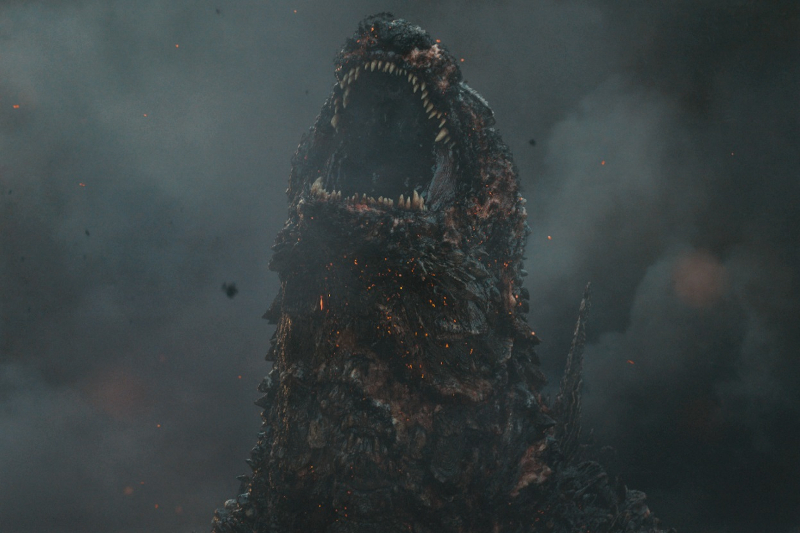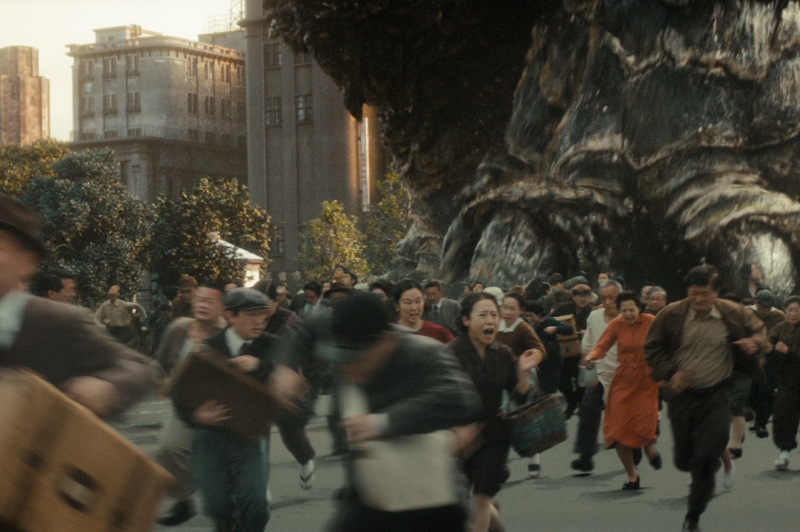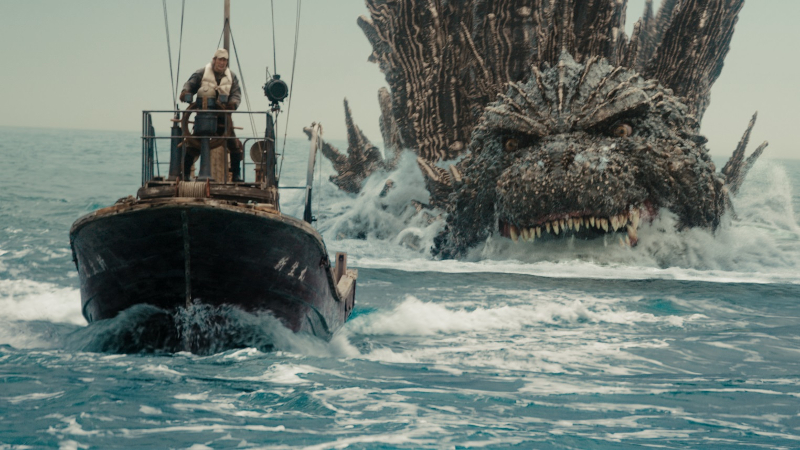Director – Takashi Yamazaki – 2023 – Japan – Cert. 12a – 124m
*****
Japan, defeated and demoralised after World War Two, must somehow defeat the seemingly unstoppable menace of Godzilla when it rises from the depths of the ocean – out in UK cinemas on Friday, December 15th
World War Two, Pacific theatre. Unwilling Kamikaze pilot Koichi Shikishima (Ryunosuke Kamiki) feigns engine trouble and lands on an island for aircraft maintenance, where he is grounded. While there, he notices deep sea fish curiously floating on the surface of the surrounding ocean: they presage the arrival of a huge monster, named Godzilla by the locals. With Koichi failing to fire his 20mm aircraft guns at the creature to kill it, almost everyone else on the small island is killed. (Whether his guns would have had any effect in halting the creature’s advance is debatable. They probably wouldn’t have had any effect whatsoever.) The only other survivor, who had previously congratulated Koichi for a near impossible landing on a tiny runway, blames him for the multiple deaths because he didn’t pull the trigger.

In 1945, in the ruins of post-war Tokyo, Shikishima is accused by a survivor – a woman whose children have died – of being a disgrace. Had he done his duty and sacrificed himself, Japan would not have lost the war and fewer civilians would have died. (Again, a completely misplaced belief. Japan would have lost either way.) In a marketplace, he finds himself suddenly handed a baby by a woman fleeing cries of, “stop thief”. When she later finds him to collect her baby, he learns the woman Noriko Oishi (Minami Hanabe) was trying to steal food to feed it, and he suggests mother and baby move in with him. If this is a shot at redemption on Koichi’s part, his generous gesture – which appears to involve caring for mother and baby with no demand for wifely duties on her part, since they sleep separately – doesn’t assuage his continuing feelings of guilt for not sacrificing himself to save his fellow countrymen or prevent him having nightmares about the rampaging giant behemoth.
When he finally secures regular employment a year later, it’s a job on one of two small wooden boats decommissioning (i.e. blowing up) mines in the Pacific; wooden because a type of American mine is attracted to metal on ships’ hulls, but not wood. The two boats string a cutting wire between them to cut the chains preventing mines floating free to the surface, where they can be detonated by 13mm machine gun fire. As a former combat pilot, it turns out that he possesses the skills to judge where to aim the gun to allow for wind, tidal drift and so forth in order to hit the target mines. Deployment of the two ships near the island where he landed his plane during the war reveals the covert purpose of the job: to locate Godzilla – a task for which Shikishima realises the two small boats are completely inadequate. Then he again spots deep sea fish curiously floating on the ocean’s surface…

It’s interesting to note that over its 70-year run, Toho’s Godzilla franchise has often lost its way, in places becoming little more than either an excuse for Godzilla and other monsters to pound cities and fight each other on the screen or exercises in cute involving Godzilla’s offspring. Meanwhile, Hollywood remakes such as the excruciating, interminable 1998 Roland Emmerich version and the rather better 2014 Gareth Edwards version simply focus on spectacle and mayhem without attempting anything deeper.
The original Godzilla (Ishiro Honda, 1954) simultaneously traded in the undeniably satisfying spectacle of a monster causing mayhem trampling cities into the dust and attempted to come to terms with an unstoppable, giant radioactive force decimating areas of the country, the latter a metaphor standing in for not only the aftermath of the dropping of nuclear bombs on Hiroshima and Nagasaki, but also Japan’s much longer history of devastation from natural earthquakes. Unlike recent reboot Shin Godzilla (Hideaki Anno, Shinji Higuchi, 2016), which skilfully used the character to critique aspects of contemporary Japan and its place in the world, Godzilla Minus One bravely goes back to the time of World War Two and its immediate aftermath to take on Japan’s dubious, self-sacrificial, Kamikaze mores and invoke a collective, national war guilt. Both films successfully deliver the franchise’s trademark, spectacular monster mayhem in the process, but like the original they are ultimately concerned with much deeper issues.

To those familiar with Toho’s monster movie aesthetic of a man in a suit shot at high speed to convey the monster’s enormous mass and bulk, the superior visual effects of Godzilla Minus One, as with Shin Godzilla before it, come as a revelation. In Godzilla Minus One, on land the eponymous creature is a slowly-plodding monster trampling anything unfortunate enough to get in its path, taking out solidly-built office buildings with a sweep of its gargantuan tail, while at sea it’s a powerful swimmer smart enough to chew through detonation cables to mines sent in its direction and strong enough to hurl battleships through the air towards buildings on the coast. As it prepares to breathe blue, nuclear fire, its dorsal fins light up one by one. In the opening reel, it satisfyingly bites people to death before hurling their lifeless bodies into the distance.

Yet, while that’s what everyone comes to see – and with which they won’t be the slightest bit disappointed – what really engages you is the struggle of the main, former pilot with his personal and collective guilt. This leads to a terrific end reel in which, as Godzilla advances on Tokyo’s Ginza district, he must be lured into the sea and sunk by battleships (firing freons to cause him to sink!). The luring is to be carried out by Shikishima in an apparent suicide mission, resulting in an amazing aerial sequence with state of the art visual effects evoking the aircraft vs monster battle at the end of King Kong (Merian C. Cooper, Ernest B. Schoedsack, 1933). However, the screenplay is a lot smarter than that suggests, and hints at a viable alternative to questionable Kamikaze sacrifice.
With director Yamazaki (Lupin III: The First, 2019; Parasyte, Parts 1 & 2, 2014-15; Stand By Me Doraemon, 2014), responsible not only for the script but also for the terrific and utterly convincing visual effects, and possessing genuine vision, the result is at once every bit as spectacular as you would wish a Godzilla movie to be and, perhaps more importantly, deeply affecting on a human and emotional level. Altogether, remarkable. Unlike the equally impressive Shin Godzilla, all but thrown away by its UK distributor, Godzilla Minus One is getting a proper UK theatrical cinema release in over 400 cinema, IMAX, 4DX, Screen X and Dolby Cinema screens. This is something of a cause for celebration: go and see it on the biggest screen you possibly can.
The cast also includes Sakura Ando (Shoplifters, Hirokazu Kore-eda, 2018; Love Exposure, Sion Sono, 2008), Yuki Yamada (Shoplifters), Hidetaki Yoshioka (Fukushima 50, Setsuro Wakamatsu, 2020), Kuranosuke Sasaki (One Night, Kazuro Shiraishi, 2019), Munetaka Aoki (True Mothers, Naomi Kawase, 2020, Samurai Marathon, Bernard Rose, 2019; It Comes, Tetsuya Nakashima, 2018; Silence, Martin Scorsese, 2016).
Godzilla Minus One is out in cinemas in the UK on Friday, December 15th. Book here. All UK prints are Japanese language with English subtitles.
Trailer:
